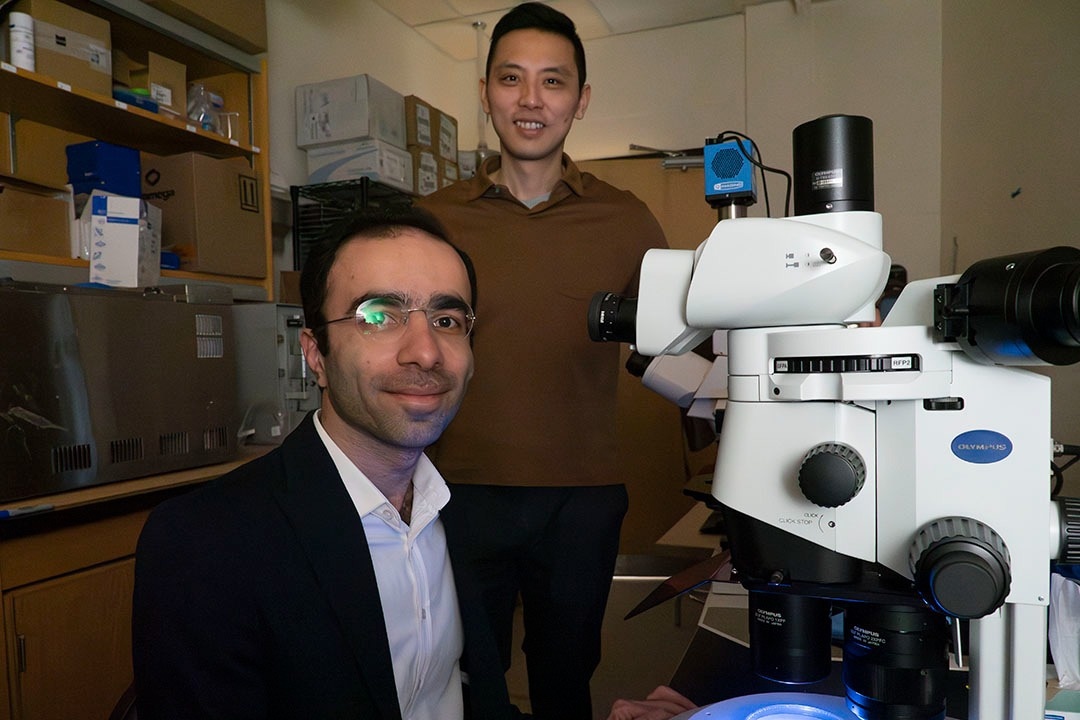The USask research team uncovered a pair of genes involved in removing cells of toxins that build in the body and cause aging while working with small nematode worms called C. elegans. The researchers discovered that inactivating genes named CCF-1 and PAL-1 caused nematodes to die 50% faster than usual.

Left to right: USask master’s student Hadi Tabarraei with his supervisor, Dr Michael Wu (PhD), analyzes nematodes with a fluorescent microscope. Image Credit: Daniel Hallen/USask.
If you remove CCF-1 gene from the worms, they become super sensitive to even the mildest amount of stressors, such as those which can cause neurodegeneration. These genes may be a key regulator in what causes premature aging in individuals.”
Dr Michael Wu (PhD), Study Senior Author and Researcher, Veterinary Biomedical Sciences, Western College of Veterinary Medicine, University of Saskatchewan
While the study was carried out on nematodes, approximately 40% of nematode genes, including CCF-1 and PAL-1, have the same function in humans. In humans, CCF-1 is known as CNOT7, and PAL-1 is known as Cdx2.
These genes can be traced back to an individual human’s ability to fight off chemical stressors at the cellular level, which then is directly linked to the rate at which they age. Our goal is, at the basic, fundamental level, to define what drives aging—age is the primary driving factor of basically every chronic human disease.”
Dr Michael Wu (PhD), Study Senior Author and Researcher, Veterinary Biomedical Sciences, Western College of Veterinary Medicine, University of Saskatchewan
“When you age, you increase susceptibility to getting cancer. When you age, you’re more prone to neurodegeneration. When you age, your metabolism slows down, and you’re more susceptible to the development of diabetes or cardiovascular failure,” Dr Michael Wu says.
Most of the investigation, which included screening all 20,000 nematode genes over the course of six months, was carried out by USask Master’s Student Hadi Tabarraei and Doctoral Student Brandon Waddell, with assistance from Undergraduate Students Kelly Raymond and Sydney Murray. Dr Ying Wang (PhD) and Dr. Keith Choe (PhD) of the University of Florida were also members of the team.
To simulate the cellular stress conditions that an organism undergoes as part of the aging process, nematodes were exposed to cadmium, a heavy metal that can accumulate in the body, and the neurotoxin acrylamide. The researchers used RNA interference to inactivate one gene at a time and discovered that nematodes with CCF-1 knocked out were more sensitive to the toxins and died at a significantly higher rate.
We were following hundreds of worms at different conditions, and tracking how long these worms go from birth to death. Nematodes only live about two to three weeks on average, so we can correlate our genetic data to a phenotype at the whole-organism level.”
Dr Michael Wu (PhD), Study Senior Author and Researcher, Veterinary Biomedical Sciences, Western College of Veterinary Medicine, University of Saskatchewan
After realizing the importance of the CCF-1 gene, the research team discovered that inactivating the PAL-1 gene created an almost identical response—the two genes work in concert to regulate the expression of multiple genes in responding to chemical stressors in the body.
The next steps in the research involve further investigation into the cellular processes in the nematode model to identify pharmacological compounds that can effectively turn on and off the genes in a controlled manner. Wu expects to pinpoint those compounds in the next five years and, in tandem, he intends to replicate the research with human cell lines and humanized mouse models, working with collaborators.
“If you want to measure whether [a pharmacological] compound has an impact on lifespan or disease development, that can take three to five years because mice can live for two years and more, normally. With an extended lifespan, it’s probably four to five years down the road,” Wu concludes.
Source:
Journal reference:
Hadi Tabarraei, et al. (2023). CCR4‐NOT subunit CCF ‐1/ CNOT7 promotes transcriptional activation to multiple stress responses in Caenorhabditis elegans. Aging Cell. doi.org/10.1111/acel.13795.